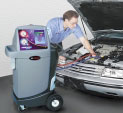1. Identify
Use of a refrigerant identifier should be the first step in any A/C service. As the price of R12 continues to rise, the number and popularity of both legal and illegal refrigerants is on the increase. To protect the technician from illegal refrigerants, some of which are hydrocarbon based, and to protect the shop's investment in a refrigerant recovery unit, it is highly recommended that a technician use an identifier prior to servicing the A/C system. Refrigerant recovery/recycling units are designed to meet SAE standards for recycling R12 and R134a only and therefore most equipment manufacturers do not warranty their recovery/recycling equipment if other refrigerants are detected.
2. Inspect
Often overlooked by an eager technician looking to get through a service as quick as possible is the basic visual inspection. You can see signs of most leaks if you look carefully. Refrigerant oil leaks out with the refrigerant and creates a film that collects dust and leaves a build up of dirt. A quick visual check of the A/C and coolant systems could result in an immediate diagnosis.
3. Diagnose
Diagnosing A/C system performance can be the most difficult and time-consuming part of any A/C repair. But, the proper tools and processes can save time and reduce complexity. A seasoned technician may even be able to do the job using just a thermometer to measure vent temperatures and temperature drops across components. (In California, the thermometer must be able to read air temperatures from 20°F to 100°F.) Also available for diagnosing A/C systems is a manifold gauge set which reads system pressures. Recently, a few manufacturers have developed test/measurement devices that make diagnosis even faster and simpler by connecting directly to the A/C system to do the analysis.
|

|

|
|
Fluorescent Dye Flex-View
(No. 3591) |
Recovery/Recycling Unit
(No. 34700Z) | |
4. Service
This involves a Recovery, Recycle, Evacuation, and Recharge process using an approved piece of equipment. All refrigerants removed MUST be recovered and not vented. Section 609 of the Federal Clean Air Act requires use of a recovery unit—even by those shops just doing “top offs”—and all R12 and R134a recovery-only or recovery/ recycling equipment MUST meet EPA (SAE) standards. They must also carry a certification stamp from either UL or ETL.
5. Repair
There are many tools and types of equipment—such as A/C line disconnect tools, clutch and compressor kits, vacuum pumps and refrigerant scales—that can help speed up repairs. Although not mandated by law, experience has shown that such tools make a real difference in both the speed and quality of the repair.
6. Verify
The last task of any job is to confirm that it has been done right. Verify performance and inspect for system leaks. Verification can be easily performed with an electronic or ultraviolet leak detector.
|
Carefully following these six steps and using the right tools can help you ensure that A/C repairs are done right the first time. That can mean happy customers and increased profits. | |